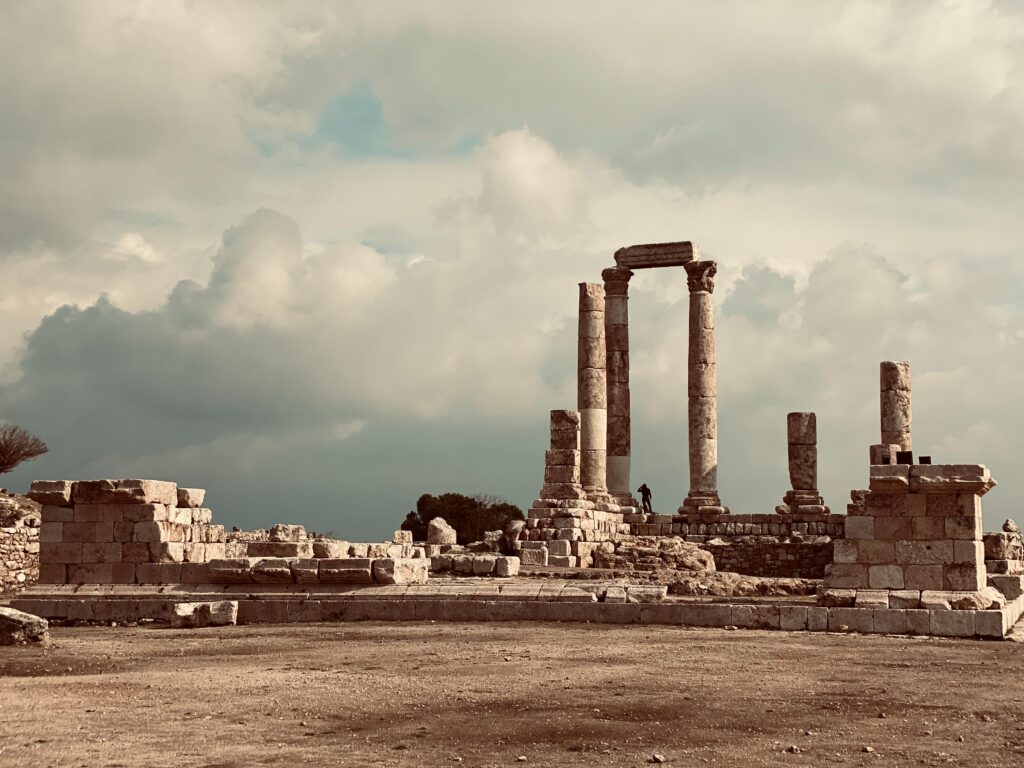Majestic Amman: A Window into History and Culture

Amman, the capital of Jordan, is a city dazzling with its historical and cultural richness. With a history dating back millennia, Amman is a true archaeological treasure that attracts visitors from all over the world. But beyond its ancient ruins and magnificent monuments, this vibrant city also offers a unique experience, with a modern setting and a fascinating blend of tradition and innovation.
The Definition of Amman
Commonly Known as “The White City”, Amman is located in the hills of northwestern JordanIt is the largest city in the country in terms of population and also serves as its political, economic, and cultural center. Founded during the Neolithic period, it became an important settlement throughout the Roman, Byzantine, and Islamic eras.
The Historical and Cultural Importance of Amman
Amman boasts a remarkable historical richness that captivates history buffs. For centuries, it was an important trading hub on the ancient spice route between the Middle East and Western Asia.
Its strategic location has attracted numerous civilizations over time, leaving behind fascinating archaeological remains. Furthermore, Amman is home to iconic monuments that bear witness to its glorious past.
Highlights include the Amman Citadel, a fortified complex housing Roman and Islamic ruins, including the Temple of Hercules; and the Roman Theater, a majestic amphitheater dating back to the second century AD that served as a stage for theatrical performances and civic events. Beyond its historical legacy, Amman is known for its vibrant cultural scene.
The city is home to a variety of museums, art galleries and cultural festivals that celebrate Jordanian heritage and promote cultural exchange between the city's diverse communities. In the next section of the article, we'll explore an overview of the city of Amman, including its geographic location, climate, and ethnic diversity.

Overview of Amman
The charming city of Amman, a treasure in the Middle East
Amman, the capital of Jordan, is a fascinating city that harmoniously combines history ancient and modern. Located in the northwest of the country, in hills surrounded by the Jordan River Valley, Amman offers a stunning and panoramic landscape. With its rich history and culture vibrant, this city enchants visitors from all over the world.
Geographical location and mild climate
Amman is situated approximately 850 meters above sea level, contributing to its mild and pleasant climate year-round. With a unique blend of Mediterranean and desert climates, Amman experiences hot summers with average temperatures ranging from 25°C to 35°C, while winters are cool with temperatures around 10°C to 15°C. These climatic conditions make Amman an ideal tourist destination in all seasons.
Diverse and ethnic population
Amman is home to a diverse population that reflects Jordan's cultural richness. While the majority of the population is Jordanian Arab, there are also significant communities of Palestinians, Syrians, Iraqis, and other ethnic groups present in the city.
This ethnic diversity creates a unique multicultural environment where local traditions blend with foreign influences. Amman's residents are known for their warm hospitality, ready to welcome visitors from around the world with open arms.
Modern infrastructure and excellent transportation options
Amman is a well-developed city with modern infrastructure that meets the needs of both residents and tourists. The city boasts a wide range of hotels, restaurants, shopping malls, and tourist attractions. Furthermore, Amman's public transportation system is efficient and accessible.
Visitors can easily get around the city using public buses, taxis, or rideshare services. The presence of Queen Alia International Airport makes arrival and departure even easier for those wishing to explore Amman and its wonders. Ancient origins of the city
Amman's history dates back to prehistoric times, with archaeological remains dating back thousands of years. These remains reveal the existence of a primitive human community in the region, which lived by hunting and gathering.
Chipped stone tools and animal bones found in archaeological excavations suggest the daily activities of these ancient inhabitants. However, it was during the Roman period that Amman began to emerge as an important city in the region.
Roman influence brought significant development to the city, with the construction of paved roads, theaters, and aqueducts. The Roman amphitheater in Amman is a stunning example of this influence, with its imposing architecture and capacity for thousands of spectators. Amman's role as an important Islamic city in the past
With the advent of Islam, Amman played a crucial role as an important Islamic city in the region. During the early centuries of Islam, the city was the scene of intellectual and cultural flourishing under the Umayyad rule.
During the Umayyad Caliphate in Damascus, several Islamic monuments were built in Amman. The Great Ummayyad Mosque is a notable example of this historical richness.
With its beautiful arches and elaborate architectural details, the mosque is a testament to the grandeur of the Islamic period in Amman. Furthermore, Qasr Al-Abd (Caliph's Palace) is another Islamic historical monument that captures the wealth and political influence of the city at the time. Islamic Historical Monuments in Amman
In addition to Ummayyad Grand Mosque and of the Qasr Al-Abd, Amman is home to a number of other historical Islamic monuments that reflect its cultural and religious importance. Nymphaeum complex is a striking example of this.
Built during the Roman period, the site was later modified to suit the needs of Muslim citizens. The original Roman features were preserved, while new additions were made to assist people with their religious practices.
Furthermore, the King Abdullah I Mosque is another important landmark in the city. Built in the early 20th century as a tribute to Jordan's modern founder, King Abdullah I, the mosque combines traditional architectural elements with a striking contemporary design.
These are just a few examples of the ancient archaeological remains and historical monuments that make Amman a city rich in history and culture. By exploring these fascinating sites, visitors can witness firsthand the layers of civilization that have shaped the city over the centuries.
The majestic Citadel of Amman
The Amman Citadel is one of the city's most iconic and fascinating landmarks. With a history dating back to ancient times, it is a living testament to Amman's rich cultural heritage.
The citadel sits atop a hill and offers stunning panoramic views of the city. Its strategic location has made it an important site for control and defense since ancient times.
The citadel houses a series of impressive ruins, each telling its own story. Among them is the Temple of Hercules, built by the Romans in the 2nd century AD, with its massive Corinthian columns still standing.
Additionally, there's the Umayyad Palace, which dates back to the 8th century AD and served as a residence for Islamic rulers during that period. The unique architecture of these structures captivates visitors and transports them to a bygone era.
Also within the citadel is the Archaeological Museum, which houses a diverse collection of historical artifacts found during excavations in the region. Visitors can explore fascinating exhibits that detail the history of Jordan from prehistoric times to the Islamic era.
These artifacts include ancient ceramics, stone inscriptions, and precious jewelry. The museum provides visitors with an educational immersion into the rich cultural heritage of Amman and Jordan as a whole.

Discovering the Roman Theater
Another must-see in Amman is the Roman Theater, a true historical gem dating back to the 2nd century AD. This ancient theater was an important entertainment center during the Roman era and is still used today for cultural events and theatrical performances. The theater's impressive structure, built in the classical Roman style, can seat up to six thousand spectators. The history of the Roman Theater is closely linked to the Roman presence in the region.
It was a place where citizens gathered to watch plays, athletic competitions, and political speeches. Notable architectural features of the theater include a semicircular orchestra, wedge-shaped seating, and an imposing stage wall.
Today, the Roman Theatre remains a popular venue for cultural events and annual festivals. During these events, the site comes alive with musical performances, traditional dances, and theatrical performances that transport visitors to the glorious era of the Roman Empire.
Conclusion
A dive into living history
Exploring the sights of the Amman Citadel and the Roman Theater is a unique experience that allows us to travel back in time and unravel the layers of the city's rich history. These historic sites are tangible testaments to the Roman and Islamic influences that shaped the region over the centuries. As we walk through the ancient ruins of the citadel, we are captivated by the grandeur of the structures and the aura of times gone by.
The Archaeological Museum invites us to delve deeper into history through its collection of precious artifacts. The Roman Theater transports us to an era when culture and entertainment were celebrated in majestic fashion.
Amman is a must-see destination for history and architecture lovers, offering an experience An enriching experience that connects us with our historical roots. By visiting these landmarks, we are reminded of the importance of preserving and valuing our cultural heritage so that future generations can appreciate this historical richness as well.
Lucas Wanderlust has a tireless spirit of adventure, always seeking new travel experiences. Fascinated by the world and the possibility of exploring unknown destinations, he fell in love with the sense of freedom and self-discovery that traveling alone provides. With a backpack on his back and a heart open to the unknown, Lucas embarks on exciting journeys, where each destination becomes a unique chapter in his life story. He gives himself body and soul to the magic of solo travel, inspiring others to follow in his footsteps and discover themselves through adventure.







